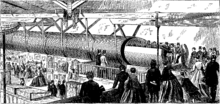
The Post Office Railway is a 2 ft narrow gauge, driverless underground railway in London that was built by the Post Office with assistance from the Underground Electric Railways Company of London, to transport mail between sorting offices. Inspired by the Chicago Tunnel Company, it opened in 1927 and operated for 76 years until it closed in 2003. A museum within the former railway was opened in September 2017.
Subterranean London refers to a number of subterranean structures that lie beneath London. The city has been occupied by humans for two millennia. Over time, the capital has acquired a vast number of these structures and spaces, often as a result of war and conflict.
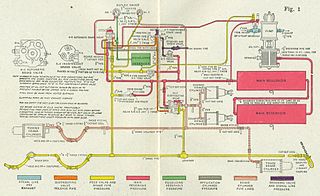
A railway air brake is a railway brake power braking system with compressed air as the operating medium. Modern trains rely upon a fail-safe air brake system that is based upon a design patented by George Westinghouse on April 13, 1869. The Westinghouse Air Brake Company was subsequently organized to manufacture and sell Westinghouse's invention. In various forms, it has been nearly universally adopted.

Pneumatics is a branch of engineering that makes use of gas or pressurized air.

Alfred Ely Beach was an American inventor, entrepreneur, publisher, and patent lawyer, born in Springfield, Massachusetts. He is most known for his design of New York City's earliest subway predecessor, the Beach Pneumatic Transit, which became the first subway in America. He was an early owner and cofounder of Scientific American and Munn & Co., the country's leading patent agency, and helped secure patents for Thomas Edison, Alexander Graham Bell, Cornelius Vanderbilt, and other innovators. A member of the Union League of New York, he also invented a typewriter for the blind and a system for heating water with solar power.

An atmospheric railway uses differential air pressure to provide power for propulsion of a railway vehicle. A static power source can transmit motive power to the vehicle in this way, avoiding the necessity of carrying mobile power generating equipment. The air pressure, or partial vacuum can be conveyed to the vehicle in a continuous pipe, where the vehicle carries a piston running in the tube. Some form of re-sealable slot is required to enable the piston to be attached to the vehicle. Alternatively the entire vehicle may act as the piston in a large tube or be coupled electromagnetically to the piston.

A Travelling Post Office (TPO) was a type of mail train used in Great Britain and Ireland where the post was sorted en route.

The Beach Pneumatic Transit was the first attempt to build an underground public transit system in New York City. It was developed by Alfred Ely Beach in 1869 as a demonstration subway line running on pneumatic power. The line had one stop in the basement of the Rogers Peet Building, near the old City Hall station, and a one-car shuttle running between the building and a dead end approximately 300 feet (91 m) away. It was not a regular mode of transportation and lasted from 1870 until 1873.
A vactrain is a proposed design for very-high-speed rail transportation. It is a maglev line using partly evacuated tubes or tunnels. Reduced air resistance could permit vactrains to travel at very high (hypersonic) speeds with relatively little power—up to 6,400–8,000 km/h (4,000–5,000 mph). This is 5–6 times the speed of sound in Earth's atmosphere at sea level.
An automated vacuum waste collection system, also known as pneumatic refuse collection, or automated vacuum collection (AVAC), transports waste at a high speed through underground pneumatic tubes to a collection station where it is compacted and sealed in containers. When the container is full, it is transported away and then emptied. The system helps facilitate the separation and recycling of waste.

Cash carriers were used in shops and department stores to carry customers' payments from the sales assistant to the cashier and to carry the change and receipt back again. The benefits of a "centralised" cash system were that it could be more closely supervised by management, there was less opportunity for pilfering, and it freed up the assistant to attend to the customer and perhaps make further or better sales.

A conveyor system is a common piece of mechanical handling equipment that moves materials from one location to another. Conveyors are especially useful in applications involving the transport of heavy or bulky materials. Conveyor systems allow quick and efficient transport for a wide variety of materials, which make them very popular in the material handling and packaging industries. They also have popular consumer applications, as they are often found in supermarkets and airports, constituting the final leg of item/ bag delivery to customers. Many kinds of conveying systems are available and are used according to the various needs of different industries. There are chain conveyors as well. Chain conveyors consist of enclosed tracks, I-Beam, towline, power & free, and hand pushed trolleys.

Prague pneumatic post is the world's last preserved municipal pneumatic post system. It is an underground system of metal tubes under the wider centre of Prague, totaling about 55 km in length. The system started service in 1889 and remained in use by the government, banks and the media until it was rendered inoperative by the August 2002 European floods.

The General Post Office (GPO) was the state postal system and telecommunications carrier of the United Kingdom until 1969. Established in England in the 17th century, the GPO was a state monopoly covering the dispatch of items from a specific sender to a specific receiver ; it was overseen by a Government minister, the Postmaster General. Over time its remit was extended to Scotland and Ireland, and across parts of the British Empire.
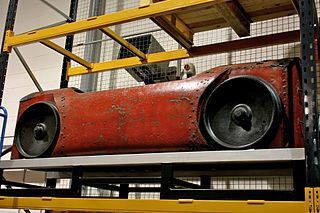
The London Pneumatic Despatch Company was formed on 30 June 1859, to design, build and operate an underground railway system for the carrying of mail, parcels and light freight between locations in London. The system was used between 1863 and 1874.
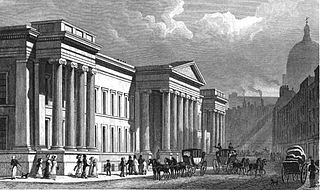
The General Post Office in St. Martin's Le Grand was the main post office for London between 1829 and 1910, the headquarters of the General Post Office of the United Kingdom of Great Britain and Ireland, and England's first purpose-built post office.

Hyperloop is a proposed high-speed transportation system for both passengers and freight. The concept was documented by Elon Musk in a 2013 white paper, where the hyperloop was described as a transportation system using capsules supported by an air-bearing surface within a low-pressure tube. Hyperloop systems have three essential elements: tubes, pods, and terminals. The tube is a large, sealed low-pressure system. The pod is a coach at atmospheric pressure that experiences low air resistance or friction inside the tube using magnetic propulsion. The terminal handles pod arrivals and departures. The hyperloop, in the form proposed by Musk, differs from vactrains by relying on residual air pressure inside the tube to provide lift from aerofoils and propulsion by fans; however, many subsequent variants using the name "hyperloop" have been relatively traditional vactrains.
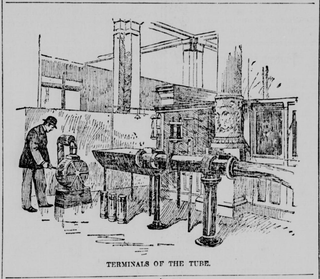
The pneumatic tube mail was a postal system operating in New York City from 1897 to 1953 using pneumatic tubes. Similar systems had arisen in the mid-19th century in London, via the London Pneumatic Despatch Company; in Manchester and other British cities; and in Paris via the Paris pneumatic post. Following the creation of the first American pneumatic mail system in Philadelphia in 1893, New York City's system was begun, initially only between the old General Post Office on Park Row and the Produce Exchange on Bowling Green, a distance of 3,750 feet (1,140 m).

The Rohrpostin Berlin, was a pneumatic tube postal service, which existed from 18 November 1865 until 1963 in West Berlin and in East Berlin until 1976.

The Paris pneumatic post was a pneumatic tube message-carrying service that operated in the French capital from 1866. It was established because of the popularity of the electric telegraph in the city which had led to the signal cables becoming overloaded and messages being sent by road. The pneumatic system allowed the telegraph companies to send messages underground through sealed lines laid in the Paris sewers, bypassing any traffic on the roads above. The network was taken into public ownership in 1879, under the Ministry of Posts and Telegraphs, and opened to messages sent by the general public. Messages continued to be considered officially as telegrams and for a fixed cost users could write a message on a "petit bleu" form to be sent anywhere in the city. After arriving at the office nearest the recipient it would be taken to their address by a courier.




